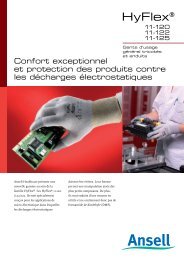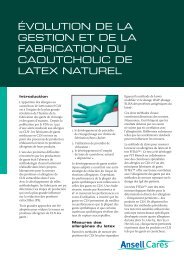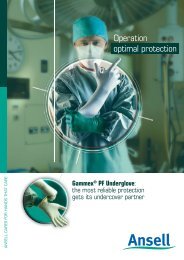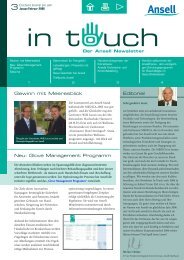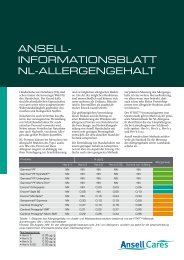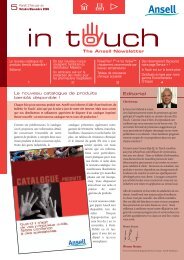Electrosurgery and Latex Gloves - Ansell Healthcare Europe
Electrosurgery and Latex Gloves - Ansell Healthcare Europe
Electrosurgery and Latex Gloves - Ansell Healthcare Europe
Create successful ePaper yourself
Turn your PDF publications into a flip-book with our unique Google optimized e-Paper software.
Underst<strong>and</strong>ing the<br />
relationship between<br />
surgical gloves <strong>and</strong><br />
electrosurgery<br />
What is electrosurgery?<br />
<strong>Electrosurgery</strong> is the application of electrical RF<br />
current to biological tissue. An electrosurgical<br />
generator supplies the source of electric current,<br />
which transfers energy (electrons) to tissue. The term<br />
‘Bovie’, a manufacturer’s trademark named after one<br />
of the early pioneers, Dr William T Bovie, is often<br />
used synonymously with the term <strong>Electrosurgery</strong>.<br />
The terms electrosurgery <strong>and</strong> electrocautery are also<br />
often used synonymously; however, this is incorrect<br />
<strong>and</strong> it is important that the two are not confused. In<br />
electrosurgery, the electrical current is applied directly<br />
to the tissue <strong>and</strong> the patient is part of the circuit.<br />
Electrocautery is the indirect application of electrical<br />
current by heating a conductive element, which<br />
burns tissue. Another distinguishable difference is<br />
that electrosurgical units are considered AC energy<br />
sources <strong>and</strong> electrocautery units are DC sources. An<br />
electrosurgery source is quickly identifiable in the<br />
operating room by the ground electrode applied to the<br />
patient.<br />
Diagram 1<br />
At the point that the current passes through the<br />
active electrode, the electrical energy is converted into<br />
thermal energy that produces high-energy heat. The<br />
heat causes disintegration of tissue cells, which may be<br />
seen as desiccation (destruction), or hemostasis of the<br />
tissue. Of course, the effect upon the tissue depends<br />
on a multiplicity of factors such as the amperage of the<br />
How common is<br />
electrosurgery?<br />
The use of electrosurgery during an operative<br />
procedure is almost as common as wearing gloves.<br />
There are various energy sources <strong>and</strong> methods<br />
employed with the use of electrosurgery. Radio<br />
frequency current is typically used by the surgeon<br />
to cut tissue or to obtain hemostasis (stop bleeding).<br />
<strong>Electrosurgery</strong> is a safe <strong>and</strong> an efficient instrument<br />
for both invasive <strong>and</strong> Minimally Invasive Surgical<br />
(MIS) procedures.<br />
How does <strong>and</strong><br />
electrosurgical unit<br />
operate?<br />
The circuitry of an electrosurgery unit is composed<br />
of the generator, <strong>and</strong> active electrode (h<strong>and</strong>-held<br />
instrument), the patient <strong>and</strong> the patient return<br />
electrode which is sometimes referred to as the<br />
passive or ground electrode (patient pad or plate).<br />
Electrons or the the electrical charge travel from the<br />
generator through the active electrode, through the<br />
patient <strong>and</strong> returns to the generator via the patient<br />
ground electrode, completing the electrical circuit.<br />
See Diagram 1.<br />
electrical current, the size of the active electrode tip <strong>and</strong><br />
the time the electrical generator is activated. A final,<br />
but very important point to consider is the absolute law<br />
of electricity, which is: ‘electrical current always follows<br />
the path of least resistance’. During electrosurgery, if<br />
the environment so dictates, the h<strong>and</strong> of the operating<br />
surgeon or assistant may offer the optimal path.



